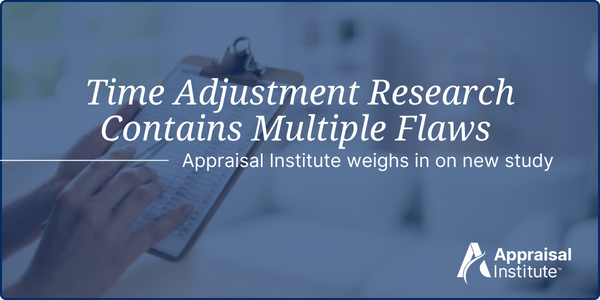Time Adjustment Research Contains Multiple Flaws
A study on the use of time adjustments by appraisers conducted by two researchers at the Federal Housing Finance Agency in November contains serious flaws that misrepresent the appraisal process and further demonize the appraisal profession regarding racial bias. The study, Underappraisal Disparities and Time Adjustments to Comparable Sales Prices in Mortgage Appraisals, contends appraised values often fail to reflect rapidly increasing home prices in competitive markets. It further casts housing equity concerns, claiming that time adjustments are used less in curing “underappraisal” in majority Black and Hispanic neighborhoods than in major White neighborhoods. The study suggests appraisers should use automated valuation models and lenders should randomly assign appraisal orders to mitigate bias.

For one, the assumption that appraisals should perfectly mirror the pace of rising market prices oversimplifies the role of appraisers and the appraisal process. The study does not sufficiently account for the complexity of making time adjustments in markets with uneven price growth or where transaction volumes are low, limiting the availability of comparable sales.
The study also interprets caution by appraisers as “underappraisal,” when this may represent a prudent check against market volatility. In rapidly appreciating markets, appraisals may appear low compared to contract prices, but this could serve as a risk-mitigation tool, in protecting buyers from overpaying during speculative bubbles.
Further, the research ignores critical dynamics of the appraisal process in how comparable sales may be accounted for by appraisers in the narrative section of appraisals. For example, in some markets, a market change might occur with an increase of as much as 1% per month. Therefore, a comparable sale that is as recent as 2 or 3 months ago, could require a 2% or 3% positive adjustment to the sale price. On the other hand, with a market that is moving at a mere 3% a year, then a three-month old sale would correspond to only a .75% adjustment. An appraiser might well not apply such adjustment, as it could be argued as being of virtual rounding error. An appraiser might well handle the issue in the reconciliation of the three to four or more comparable sales presented in the sales comparison approach, which is completely overlooked by the study.
There may be a myriad of other factors at play. For instance, and for whatever reason, an appraiser’s analysis could indicate that one of the comparable sales sold on the “high” side. Applying a time adjustment for an above-the-market sale, while requiring explanation, might not be appropriate at all.
The study also leans heavily on the use of automated valuation model information from Zillow, which has its own credibility and accuracy problems.
Near the end, the study makes passing reference to lender-appraiser dynamics, which may be more exculpatory to the findings. For instance, no effort was conducted to analyze whether appraisers faced pressure from underwriters or reviewers to remove time adjustments from appraisals. We are not far removed from the days when steadfast appraisers who “stuck to their guns” were routinely dismissed by lenders and appraisal management companies.
Lastly, while the study may find differences in underappraisal rates across racial or socioeconomic lines, it could overemphasize bias without fully exploring the influence of broader systemic issues such as zoning laws, lending practices or other economic factors. Correlation is not the same thing as causation. Other factors such as property conditions, neighborhood trends, or buyer/seller behavior might explain some of these patterns.
It is common for government researchers to seek feedback from practitioners and industry groups in conducting research on complex issues such as appraisal. While authoritative texts, such as the Appraisal of Real Estate, 15th Edition, were reviewed, we are not aware of any field appraisers or industry representatives that were consulted in the design or review of any of the research findings. The next study, if there is one, can and should do better.